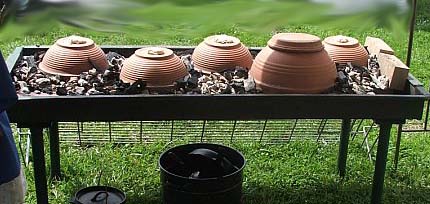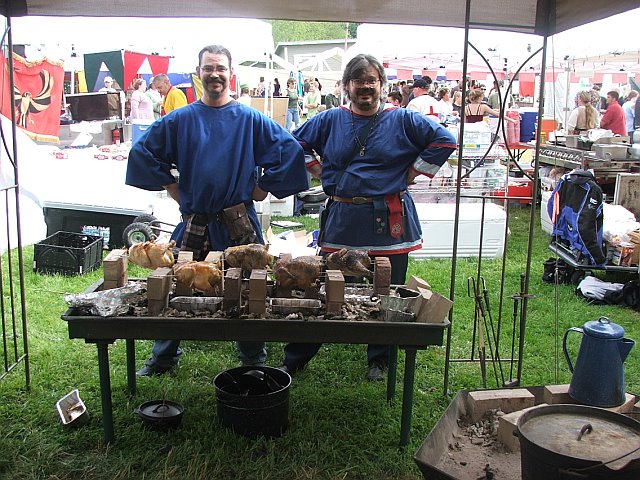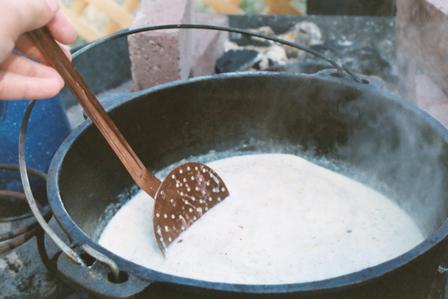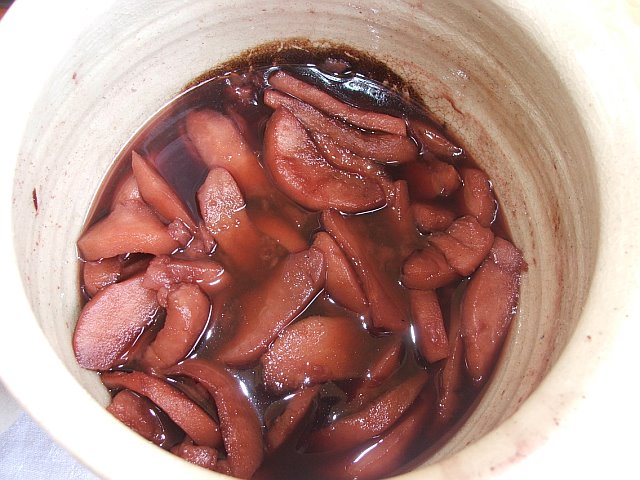| Main Recipe Index |
|
|
|
A Simple Supper for an Evening at Junefaire Hearth
Baked Bread Roast
Chicken |
When Their Excellencies approached the Guild to prepare a small dinner at Junefaire for Their visiting Cousins, it presented us with a new challenge. While we had many aggregate hours of feast experience among our members, those hours had been collected in kitchens furnished with modern conveniences such as running water, refrigeration and gas or electric stoves.
Preparing a feast at Junefaire would be different. There we would have our medieval demonstration kitchen; our large Baronial Brazier, assorted cast iron and crockery cook pots, our water pig and refrigeration only in picnic coolers tucked back under the tables and covered with cloths. Still the guest list was small, a dozen or so invited guests, and with modern kitchens only a few miles away for backup, the challenge was accepted. (For a more detailed account of our demo Kitchen see Evolution of a Demo)
We had been doing our demo kitchen for several years and now had a repertoire of dishes we were familiar with cooking on the brazier. (For more of our recipes see Junefaire recipes and cooks page.) While Their Excellencies were clear that period dishes were not expected, we would need to do at least some of the preparation during the public hours of Junefaire and period recipes would best fit into the demo. (And besides if you're not going to go period why not just order pizza for delivery.)
All dishes, with the exception of the cheeses, were prepared on site over charcoal fires in our demonstration kitchen. Nearly all of the dishes had been previously prepared in our demo kitchen but not in the quantities needed or on a set serving schedule.
 Hearth Baked Bread
- The first obstacle to tackle was the bread. Cloche baked bread
has always been a staple of the demo, but baking the loaves one at a time even
if we worked all day would be inefficient and take up valuable space on the
brazier. We needed more baking space. A second brazier became available on loan
from the local Eagles Hall. This one was made of a thinner metal than our
original but lining it with bricks provided the needed thermal mass. We still
needed more cloches. In my search for more I found a smaller and much cheaper
pot at a local home improvement store. Would it work? A month of testing proved
it nearly as good as the original, although it was best to make a slightly
smaller loaf. We started baking first thing in the morning and with two bakes
had plenty of good loaves for supper and a couple for the cooks.
(At right- Baking in progress under four small
cloches and one large. We use a saucer to seal the large cloche but skipped the
expense and plugged the smaller ones with a knot of salt dough.)
(For
more on our cloche baked bread see
An Experiment in
Bread Baking and
bread making page.)
Hearth Baked Bread
- The first obstacle to tackle was the bread. Cloche baked bread
has always been a staple of the demo, but baking the loaves one at a time even
if we worked all day would be inefficient and take up valuable space on the
brazier. We needed more baking space. A second brazier became available on loan
from the local Eagles Hall. This one was made of a thinner metal than our
original but lining it with bricks provided the needed thermal mass. We still
needed more cloches. In my search for more I found a smaller and much cheaper
pot at a local home improvement store. Would it work? A month of testing proved
it nearly as good as the original, although it was best to make a slightly
smaller loaf. We started baking first thing in the morning and with two bakes
had plenty of good loaves for supper and a couple for the cooks.
(At right- Baking in progress under four small
cloches and one large. We use a saucer to seal the large cloche but skipped the
expense and plugged the smaller ones with a knot of salt dough.)
(For
more on our cloche baked bread see
An Experiment in
Bread Baking and
bread making page.)
Artisanal Cheese - The cheeses were the one item not prepared on site. They were made by our own little cheese maker HL Aelianora de Wintringham at her home, Fox Dog Farms, where she raises organic produce and pygmy goats. Both a plain goat cheese and one with chives were served.
 Stew
of Cabboges- The original of this recipe is found in the Forme of
Cury. We use the redaction from The Compleat Dagger-Lickin' Good with a few bits
of tweaking in the spices. It is the one recipe we used that has not been
redacted by one our guild members. (The
photo at left is a pot stewed up at a previous demo. Note the use of
reproduction pottery.)
Stew
of Cabboges- The original of this recipe is found in the Forme of
Cury. We use the redaction from The Compleat Dagger-Lickin' Good with a few bits
of tweaking in the spices. It is the one recipe we used that has not been
redacted by one our guild members. (The
photo at left is a pot stewed up at a previous demo. Note the use of
reproduction pottery.)
Roast Chickens
- While this treatment is not directly from a medieval recipe roast meats were
typically served at feasts and, in particular, at outdoor meals as seen in
period illustrations of picnics. (See illustration at top of the article.)
The bricks used for a thermal base while baking were up-ended and
pressed into service as spit rests. We do not at this time have proper spits but
are making do with a pair of long metal skewers per chicken run down through
breast and thigh. The birds were stuffed this time with clove-studded apples,
cinnamon and onions. At other times we have st uffed the birds with apples and
herbs or lemons and onions. A three to four pound chicken will need two or
three hours over the coals and turned several times to ensure even roasting.
Our chickens roasted for nearly three hours on this occasion. We have been
very extremely pleased with the texture the birds acquire with this method. The
meat is moist and tender and never stringy. Drip pans remain a controversy and
a problem. We cheated a little this time with foil ones. The original disposable
loaf pans did not fare well in the fire and succumbed to the heat. We replaced
them with hand-made foil ones. We have used crockery ones in previous demos but
find them highly prone to breakage both from heat and handling. The roast bird
makes a spectacular display both on the spit and on the table.
(At left Fric and Frac also known as Charles the
Plain-Spoken and Theodorick the Scholar watch over the chickens.)
uffed the birds with apples and
herbs or lemons and onions. A three to four pound chicken will need two or
three hours over the coals and turned several times to ensure even roasting.
Our chickens roasted for nearly three hours on this occasion. We have been
very extremely pleased with the texture the birds acquire with this method. The
meat is moist and tender and never stringy. Drip pans remain a controversy and
a problem. We cheated a little this time with foil ones. The original disposable
loaf pans did not fare well in the fire and succumbed to the heat. We replaced
them with hand-made foil ones. We have used crockery ones in previous demos but
find them highly prone to breakage both from heat and handling. The roast bird
makes a spectacular display both on the spit and on the table.
(At left Fric and Frac also known as Charles the
Plain-Spoken and Theodorick the Scholar watch over the chickens.)
Saffron Millet - The original comes from Le Viandier de Taillevent. Below is the English translation by James Prescott.
"Wash it in three changes of hot water and put it in simmering cow's milk. Do not put the spoon in it until it has boiled, then remove it from on top of the fire and add a bit of saffron. Boil it until it is done."
Modern Redaction
-
3 cups whole milk
-
1 cup millet
-
a pinch of saffron threads
-
salt to taste
Bring milk to a simmer. Meanwhile rinse and drain the millet, removing any small bits of chaff or stones. (Modern millet is usually very clean. And this step may be skipped without serious damage to the dish. If you cannot find millet at your grocer it is usually carried in health food stores. ) Add millet and bring just to a boil, stir well and remove it from heat. Add in saffron (for a deeper color toast your saffron first) and return to (Low) heat and cover and cook till done stirring frequently. (around 20 minutes or so watch for too much heat as it can boil over and can stick to pot. ) Millet should be tender and thick like sticky rice or polenta. It makes a very nice and bright yellow dish. Make sure to serve it hot rather than reheating it.
Salat- What can I say about a salat? We used a mix of spring greens dressed with a simple dressing of olive oil and red wine vinegar, salt and pepper and this time a little roast garlic added in. It is a common enough dish in medieval menus in the spring and early summer but we know the recipe more from literature than from cookery texts. (See Modern Dishes in Medieval Guise; The Salat for more info.)
On to Dessert-
 Our
custard recipe comes from one of my favorite period sources, The Cookbook
of Sabina Welserin. It caught my eye when planning our first demo as the
instructions call for a technique clearly related to modern Dutch oven cookery
of placing heat above and below the pot. English Translation by Valoise
Armstrong. (At left- stirring the custard
at a previous demo.)
Our
custard recipe comes from one of my favorite period sources, The Cookbook
of Sabina Welserin. It caught my eye when planning our first demo as the
instructions call for a technique clearly related to modern Dutch oven cookery
of placing heat above and below the pot. English Translation by Valoise
Armstrong. (At left- stirring the custard
at a previous demo.)
"Another tart
Take four glasses of milk, twelve eggs and seven ounces of sugar and one half ounce of ginger and some ground cinnamon. One must afterwards beat everything together, then put a little fat into a pan and put the batter into it and stir it around, until it begins to thicken. Then put the cover on the pot and hot coals over it. And there should be no more heat on top of it than under it, or else the batter will be bubbly. And when you see that it begins to set up, sprinkle some cinnamon and sugar on top."
Modern Redaction
-
6 cups milk
-
12 eggs
-
15 tablespoons of sugar (Not quite 1 cup)
-
1 tablespoon ground ginger
-
1/4 teaspoon ground cinnamon
-
1/2 cup butter (This could be reduced to 1/4 cup possible)
-
sugar and cinnamon to sprinkle on top
Combine sugar and spices and set aside. Beat eggs, add milk and sugar and spice mixture. Melt butter in three and a half quart pan (min size). When it is quite bubbly but not yet browning, pour in batter. Cook over medium heat, stirring constantly, to scrape bits of cooked custard off bottom of pot. When cooked bits seem to be about half of total volume, cover and heap coals on top of pot, heat should be even on top and bottom. Bake till set (or at home, slip into oven preheated to 350 degrees. Time will vary due to how much cooking occurred on top of stove, but at least 20 minutes in most cases) sprinkle sugar and cinnamon on top to taste. This dish has a sort of pebbly texture, sort of a cross between fine scrambled eggs and a smooth custard and there will be a good amount of clear liquid around the edges of the pot. More liquid will form as it cools. This custard may be sliced and served hot or cold.
Cherry Fritters - This is another recipe from the Sabina manuscript. I had originally planned on serving these fritters as a sweet dish in the first remove but was unable to have them ready at the beginning of the dinner. But who ever objects to extra dessert?
"To bake sour cherry puffs
Take hot water, lay fat the size of a walnut into it, and when the fat is melted, then make a batter with flour, it should be thick. Beat it until it bubbles, after that thin it with egg whites. If you like, you can also put a few egg yolks into it. Tie four sour cherries together, dip them in the batter and fry them. Shake the pan, then they will rise. The fat must be very hot."
Cherry puffs (Modern redaction)
-
2 tbsp lard or other fat
-
1/2 cup hot water
-
1 cup sifted flour
-
2 egg whites (Or one whole egg, beaten)
-
1 pound sour cherries. (See notes)
Melt lard in hot water. Beat in flour in small increments till it blisters. Dough will get very stiff and clumpy, thin with egg whites. (Make sure to have some extra ingredients on hand. This batter has a tendency to thicken as it sits and you may need to adjust the viscosity)
Dip cherries into batter 3-4 at a time to make small fritters. And fry till lightly browned. This batter stays light colored.
Notes on cherries: The original calls for fresh cherries with stems to be tied together in bundles of 4. If you can get them fresh go for it. You may pit the cherries or leave the pits in, but be sure to warn your guests. Pitting the fresh cherries is difficult to do while retaining stems, but it can be done with practice. Frozen or canned/jarred cherries work just fine. Thaw and/or drain well before dipping in batter.
 Wardyns
in Syrup- (pictured at left)
We had not previously made this recipe on the brazier but the process was simple
enough to give us no worries. This dish made a nice talking point for the
introduction of humoral theory to the public. Many versions of the recipe can
be found in medieval texts but we took our original from Harliean MS 279/4016 as
edited by Cindy Renfrow.
Wardyns
in Syrup- (pictured at left)
We had not previously made this recipe on the brazier but the process was simple
enough to give us no worries. This dish made a nice talking point for the
introduction of humoral theory to the public. Many versions of the recipe can
be found in medieval texts but we took our original from Harliean MS 279/4016 as
edited by Cindy Renfrow.
Wardonys or Pears in Syrup Modern Redaction
-
5 large Bartlett pears. (about 4 lbs)
-
1 cup red wine
-
1 tsp ground cinnamon
-
1 cup sugar
-
1 tsp ground ginger
-
pinch of Saffron
-
1 tbsp red wine vinegar
Combine wine and cinnamon. Set aside while preparing pears.
Wash pears and boil unpeeled in water till cooked (about 15 minutes)
Remove from water and let cool, peel and cut into halves or quarters depending on size of fruit. Slice out cores. (For this presentation we further sliced the pears for smaller portions.) Strain wine and spice mixture through fine sieve and discard spice powder still in sieve. Add sugar and bring to boil till all sugar is dissolved. Add in pears, remaining spices and vinegar Bring back to a boil stirring pears down into syrup and cook another 5 minutes to blend flavors.
 Final words -
An apple and pear spread for the bread and a sauce of roast garlic that had been
made during the day's demo were added to the menu at the last minute. I am
greatly indebted to the willing hands of Theodorick the Scholar, his Lady,
Gabriel de Cameron, Margaret, Charles the Plain-Spoken, Mattuesz z Plocka, Lydia
z Polska.
Final words -
An apple and pear spread for the bread and a sauce of roast garlic that had been
made during the day's demo were added to the menu at the last minute. I am
greatly indebted to the willing hands of Theodorick the Scholar, his Lady,
Gabriel de Cameron, Margaret, Charles the Plain-Spoken, Mattuesz z Plocka, Lydia
z Polska.
The dishes were served under a star strewn canopy to the accompaniment of fine music and convivial company. And by all reports much enjoyed.
Sources:
-
Renfrow, Cindy, Take a Thousand Eggs or More, a Collection of 15th Century Recipes, Volume Two, privately published 1990
-
Mistress T'Sivia bas Tamara v Amberview, The Compleat Dagger-Lickin' Good, Raymond's Quiet Press, Albuquerque, New Mexico, 1986
-
Prescott, James, trans., Le Viandier de Taillevent, 14th Century Cookery, Alfarhaugr Publishing Society, Eugene Oregon, 1989
-
Armstrong, Valoise, trans., The Cookbook of Sabina Welserin, published privately on-line and in limited edition, 1998
Copyright 2006 by Laura J. Henson aka THL Rycheza z Polska Posted Recipt Book of Rycheza z Polska 2011
Return to Articles.
